Visitors & Expats
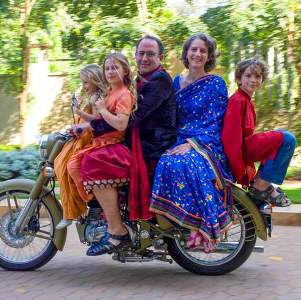
India isn’t for everyone. But it’s a must-see destination for curious, adventurous travelers who seek out rather than shy away from surprises. For new and veteran visitors, the time to go there has never been better. Khabar presents the experiences of a first-time tourist from Atlanta, and the perspectives of several expats living in India.
“Why is Incredible India such a poor show?” asked one magazine headline. “Why India is not so ‘incredible’ for tourists” said another. Given the country’s wealth of historical, cultural, and natural treasures, it’s indeed a shame that foreign tourism figures continue to be so unimpressive. Even tiny Singapore draws more visitors annually. True, travelers to India face multiple challenges, not least its still creaky infrastructure. But there have been several improvements in recent years. Not to forget, the rupee has been pretty weak lately, giving foreigners great value for their money in India. That affordability extends to medical tourists like Atlantan Franklin Abbott, who writes about his visit to India in the first part of our cover story. But the attraction is not confined to tourists and NRIs. India is home to many Western and other expats who, as Bangalorean Deepa Padmanaban reveals in the second part of our story, become long-term residents for various reasons.
| Indelible Images of India |
| By Franklin Abbott |
India, for me, was not just another country on another continent. India was another dimension, another way of perceiving reality, a society as old as human civilization and as complicated. What I learned about India is what a beginner learns. Since I have returned to Atlanta, reading about India has become an obsession.
Let me be honest. It was a need for a colonoscopy that funded my first trip to India in 2007. Six years ago it cost over $5000 and being self-insured, I would have to pay for it all out of pocket. I had read about medical tourism and India was always mentioned as a good place to go. So I went.
The image of India that always called to me was the Taj Mahal. We had few books in my family home when I was growing up. Around the World in a Thousand Pictures was one of them. It was there that I first saw a picture of the Taj Mahal. I knew that I wanted, needed to go there. Was I there in a past lifetime? If I was it was one of many lifetimes in India I revisited when I visited.
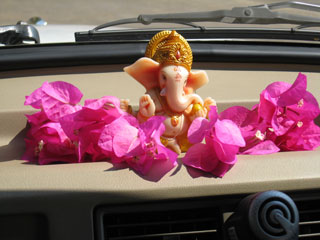
Jagi’s dashboard Ganesh.
I do get attached to people and places. I think about Jagi, my driver in the South who reluctantly allowed me to sit in the front of the Ambassador that he drove me in. One of my favorite images from India is the freshly garlanded Ganesh on his dashboard. Jagi drove me to the foot of Gommateshvara. This statue of a venerated Jain teacher was another primal image of India. I had to climb six hundred tiny steps up the hot rock face of Vindyagiri Hill in my stocking feet to see him. He is a thousand years old and the world’s largest human figure carved from stone. He is completely naked. Jagi drove me on to the temples at Halebid and Belur. While the Middle Ages were ending in Europe these amazing temples were being carved by hand by generations of expert craftsmen. I was truly humbled as I walked around them and dismayed that I had not studied this art in art history class.
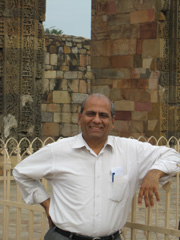
Travel guide Ashok Kumar at the Qutab Minar.
When I decided to go to India I asked a friend who had visited the year before about how he set things up. I came to know of an agent in New Delhi who specialized in setting up tours for Americans and Europeans. I wrote to Ashok Kumar, explaining why I was coming and that I had a number of sites I wanted to see. I didn’t want to stay in fancy hotels or in ashrams. I told him that I got lost easily and would find it difficult to navigate buses and trains on my own. He put together a near-perfect agenda for me. The only thing he dissuaded me from doing was going to Varanasi. It was late in the season and the heat would be unpleasant. He recommended I make my pilgrimage to the Ganges to the temple towns of Haridwar and Rishikesh and arranged for me to go on to the even cooler hill station of Dehradun and then to Mussoorie where I would meet the beloved Anglo-Indian writer Ruskin Bond. That was the first part of my journey.
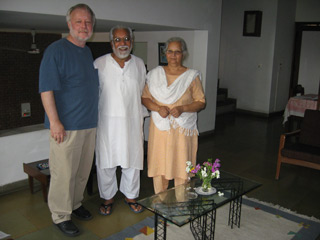
Abbott with Dr. and Mrs. Sharma.
Ashok met me at the New Delhi airport in the middle of the night and took me to my homestay at the residence of Dr. and Mrs. Sharma, who would be my hosts for my first nights in India. Dr. Sharma is a retired physician and arranged for one of his colleagues to do my colonoscopy. He and Mrs. Sharma treated me kindly, like a child almost, which I was in a sense given how naïve I was about where I was. When you are a stranger in a strange land, as I was in India, even knowing the right questions to ask is difficult. I ask questions for a living and I am good at it but I knew I was out of my depth. When I go back I want to be better prepared with better questions.
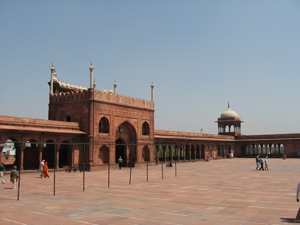
Courtyard of the Jama Masjid.
In New Delhi, Ashok took me to the Sikh temple, the Jama Masjid and a huge new Swaminarayan Temple across the river. In each place I was moved, amazed and bewildered. He then dispatched me with a driver to Agra to see the Taj. I wanted to stay overnight so I could see it twice, once in the evening and once in the morning. Oddly enough the only thing I can compare it to in my travels around the world is the Grand Canyon. I thought I knew what the Grand Canyon looked like through photographs. I didn’t. Nor did I know what was in store for me when I walked through the gate and stood on the platform looking at the Taj. I had never seen such a beautiful building in all my travels. I knew the story of the heartbroken emperor who built it as a memorial for his beloved queen after her death. I had thought the story a mere fable but here in front of me was proof positive that love defines the best of our human nature.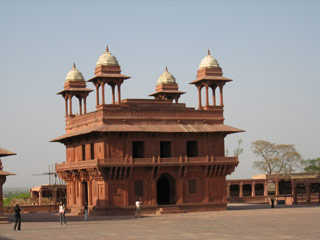
Fatehpur Sikri in Agra.
I left Agra and went on to Fatehpur Sikri, another wonder of the world, a spiritual city built and abandoned by the Emperor Akbar who was perhaps the first Unitarian. I was again taken by a place into its story and drawn more deeply into the complex issue of religion in India. I did ride the train twice. My driver in the North, Vinod, dropped me at a station north of Agra to take a train that would put me closer to Karauli in Rajasthan. I left the train in the dark of night and was driven over rough roads lit only by homefires and stars to the country palace of the Maharaja of Karauli by his bodyguard accompanied by uniformed members of his militia.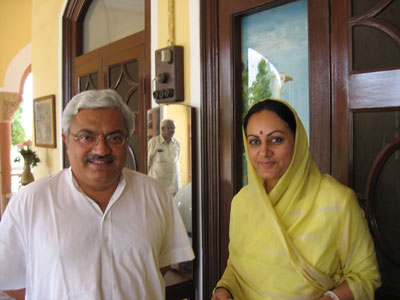
The maharaja and maharani of Karauli.
After breakfast the next morning I toured the city palace and saw some of the most beautiful paintings I’ve ever seen and was dropped back at the country palace where a man my age in white pajamas was standing on the veranda. I said hello and introduced myself. He told me he was the maharaja and I asked him innocently what I should call him. He looked at me kindly and said, “Maharaja.” He invited me, if I was up to it, to accompany him on his rounds that day. After a visit to another palace, followed by lunch and a nap, we visited an agricultural project and then had tea in a desert forest. His militia men served us out of fine china as we sat on the rocks and ate finger sandwiches.
Back at the country palace I dined with him and his wife the maharani. She was ten years his junior, beautiful and very funny. She took me on a tour of the palace the next day to show me what she had done to redecorate. We talked about her children, her life as a royal. Like her husband, she was invariably kind. Like her husband she also knew she was different from everyone around her. Perhaps that is why she confided in me. As a foreigner I had no status in her world. I could be treated like a friend and was.
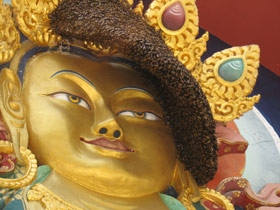
Honeycomb over the Buddha’s eye in Dehradun.
I stayed with another lovely family in Dehradun. Mr. and Mrs. Mehta had lived for many years in Darjeeling, another hill town, where Mr. Mehta had run a tea plantation. They now lived in a comfortable home with a family of servants and a Dalmatian. Mrs. Mehta served me the best cup of tea I had ever had from the plantation her husband had once run and which now sent them an annual ration. She said it was so delicate it could only be sweetened with honey and explained further it was not the best of the best but the second best of the best. I was learning that in India status is related to just about everything. I visited the Tibetan Buddhist monastery in Dehradun, a relatively young institution with some very large Buddhas. One of the things I have noticed about Buddhist art is the emphasis on symmetry. So it was odd that one of the big outdoor Buddhas had a funny dark area over one of its eyes. Lucky for me it was Sunday and the observation deck just below was open. When I went up to look that dark mass was a beehive full of buzzing bees.
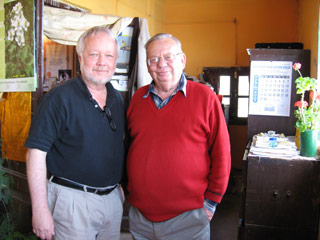
Abbott (L) and author Ruskin Bond in Mussoorie.
From Dehradun I continued up to Mussoorie where I met Ruskin Bond. I admit that his name was not one from the literature books of my youth as it was for many of my Indian friends. Before I arrived in Mussoorie I had spoken with Ashok by phone who warned that Mr. Bond was not keeping well and might not be able to meet me in town for lunch. Mr. Bond was kind enough to let me stop by to visit him in his home where he lived with a family of Indians who were his servants. He was relieved, I think, that I wasn’t a huge fan with a thousand questions. He is of British descent, born in pre-independence India, and he had an Indian stepfather. He decided to stay and wrote about the country that was his home in such a way as to endear himself to Indian readers, especially children. His home was as humble as he, with no luxuries. But the view from his door of the foothills of the Himalayas was breathtaking.
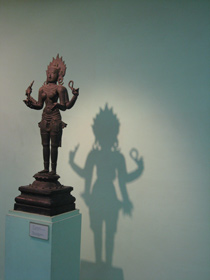
Bronze Chola statue in a Delhi museum.
Back in New Delhi I went to the National Museum to see the bronzes, to the Folk Museum to see and be photographed with underpaid, petulant tribal dancers and buy Mithila paintings for gifts to take home. Ashok took me to the magnificent Qutab Minar and to the hospital for my scheduled colonoscopy. I was taken to a room where my colonoscopy would be performed while Ashok went and paid my bill (pay first, no billing). My anesthesiologist, a young woman, came in and introduced herself. When I explained I had to wait for Ashok to return to give him my passport she smiled and said, “If you can trust me with your life, you can trust me with your passport.” I surrendered both and when I woke up Ashok and Dr. Sharma were there to take me to lunch in a nearby hotel. That afternoon I was on a plane to Bangalore where Jagi would meet me.
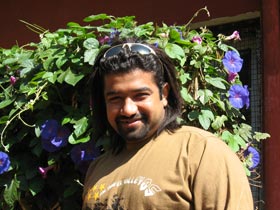
Acha Kamath in Ooty.
After my adventures on the rock of Vindyagiri and my darshan of Gommateshvara and my visit to the temples at Halebid and Belur and my stay at a nearby resort, which offered me my first experiences with heavenly Aryuvedic massage, I was dropped at the Ginger Hotel in Mysore. I had stayed at the Ginger Hotel in Haridwar and loved it. I had come to Mysore at the invitation of a pen pal, a friend I made via the internet and our mutual interest in jazz. Acha was unlike all the other Indians that I met in that he was much younger, and his English was influenced by American movies and TV. My other Indian connections spoke a version of the Queen’s English. Acha and I spoke the same language and shared, in addition to our musical tastes, a wicked sense of humor.
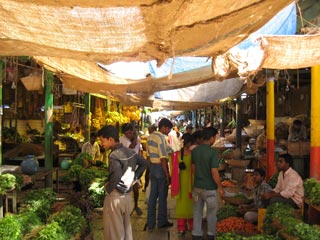
A vegetable market in Mysore.
North and South
I am so grateful to have visited both
the north and south of India. They are
more different than the northern and
southern U.S. The north has an intensity
based on density and years of conflict.
The south is more languid. The north
is sharp and the south is round. That
is from a child’s point of view and, as I
said before, in India I was naïve, a child.
Acha’s family has a spice business in
the famous Mysore Market. Acha loves
to eat and took me out for some amazing
meals. He took me up to the top of
Chamundi Hill at night to look down on
the sparkle of Mysore below. He showed
me a fifteen-second video he took on
his cell phone earlier that year when
he had been up in the same spot with
friends and a leopard had come within
feet of them. It sent chills up my spine.
Acha also took me to one of his favorite
places, the hill station at Ooty where
we stayed in what were once British barracks,
toured tea plantations and took
the toy train to Coonoor and back.
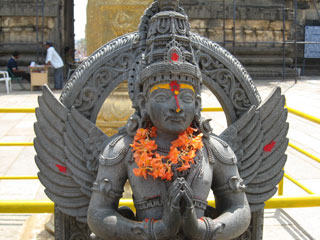
Garuda of Halebid in Karnataka.
On my way back from Mysore to Bangalore, Jagi took me to a snake temple just for photos. I saw more snake idols outside a temple in Bangalore, remnants of a religion older than the Vedas. Jagi finally agreed to join me in a meal. He had always demurred as my driver in the North had. He always slept in or near the car saying that that was what drivers did. And though it was not his choice he did allow me to sit up front so we could talk and I could ask a thousand questions. If he didn’t want to answer he would grow quiet and I learned I had crossed a boundary.
Of course I had lots of questions. The answers I got were never very direct. If I didn’t get silence I got kind indulgence. My curiosity comes from a genuine place and I think people pick up on that. I really want to know, not to judge but to know. Judgment has been one of the chief byproducts of Western civilization. Everywhere we Westerners go, we judge what we find to be inferior and worse, in need of our intervention. India has suffered mightily under the gaze of Britain and the United States. We may admire Gandhi and be titillated by the Kama Sutra but we know our ways are best. Had I gone to India as an expert I would have been lost. Going as a child I was given an opening to begin to understand.
All the couples I met who were my age or older had their marriages arranged by their parents. Mrs. Sharma explained, “In your society you fall in love and get married. In our society we get married and fall in love.” Simple words but words to ponder. I noticed how differently my hosts treated each other and their servants. I noticed how their servants treated each other and treated their bosses. It was not unlike what I saw as a child growing up in the racially segregated U.S. South. And it was different. Ashok explained to me that in a society as vast and populous as India you must have group affiliation to survive. You cannot survive as an individual. Your caste and your religion are as much about mutual aid as they are about exclusion. In a world where it is so easy to get lost, knowing your place is as much about safety as it is about status. Even my most modern Indian friend Acha had a sense about place and a sense of belonging.
India is not a static society. But it is one where traditions are cherished. One of the last things I saw before I left were the rangoli designs in rice powder that the women of Bangalore make in the morning on their doorsteps. They are a charm against misfortune and an invitation to luck. Simple but elegant, in the end these were indelible images my child’s mind could finally recognize and take to heart.
Franklin Abbott is a writer and psychotherapist in private practice in Atlanta. His latest books are Boyhood: Growing Up Male and Pink Zinnia. For more information, go to www.franklinabbott.com and www.pinkzinnia.wordpress.com.
| Calling India Home |
| By Deepa Padmanaban |
Living as an expat in any country has its pros and cons, and ups and downs—but in the end, it’s what each person makes of their experiences that matters. Several Bangalore-based expats with no ancestral ties to India share their Indian stories.
In the past, India was seen mainly as an exotic travel destination known for its spicy food and yoga ashrams, a country from which natives emigrated in search of better opportunities to more developed countries such as the U.S. or U.K. With the advent of globalization and the opening of the Indian economy, India is now seen as an important business center, attracting people from the U.S., Europe and other parts of the world. Some come to study, some to experience the culture, some are posted here through multinational corporations, and some come as entrepreneurs lured by the booming economy.
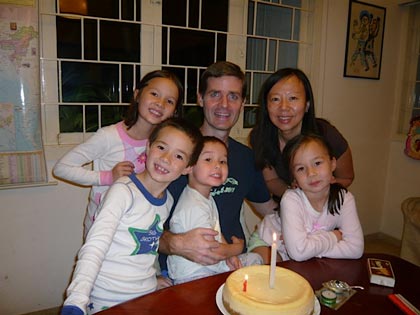
Eric Savage with wife Phyllis and children.
Bangalore—A Favored Destination
Bangalore, the IT capital of the country, is a popular
destination among expats because of its climate,
culture, and cosmopolitan environment. Eric Savage,
from Ohio, has been living in Bangalore since 2007
when a job brought him to the city with his Chinese
wife, Phyllis, and three children. The couple went on to
have their fourth child in India and plan to stay here
for “a long time.” “Bangalore’s weather is perfect, the
people are great. It’s such an innovative, diverse, culturally
rich place and it seems everyone is an entrepreneur.
Every day when you wake up in India, you know
you are alive!” says Savage.
The opportunity to explore diverse cultures and exotic destinations in and around India is an attraction to many. Beth Chapman, who moved to Bangalore from California three years ago when a job opportunity brought her husband to the city, says, “It seemed like a good opportunity professionally for him, and an adventure for the whole family. For me, the best part of living in India is the warmth and generosity of the people. I have been welcomed like family into more homes and celebrations than I can count. The openness and desire to share cultures is humbling.”
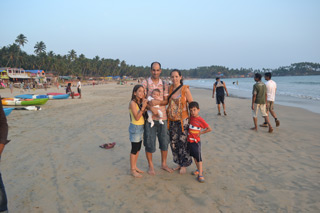
Tally Ben with family.
Tally Ben from Israel also loves “being exposed to other cultures, meeting other nationalities, celebrating Indian festivals, and traveling to beautiful places in India.” The family moved to Bangalore when Tally’s husband got a job contract for 18 months, but the Bens have extended their stay by three years since then.
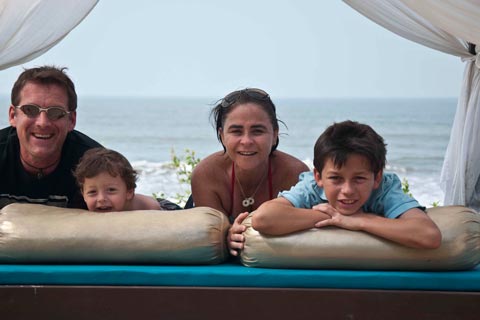
Magali Couffon de Trevos with her husband Uwe and children.
Magali Couffon de Trevos, a French national and a professional photographer, came to India 18 years ago with a backpack while on a world tour and never left. Living in Bangalore since 2002, she says she loves the culture, the smells, and the colors, most of which were familiar due to a stint in East Africa, where she grew up with Indian friends. “I chose to stay here as I enjoy my freedom here and the excitement of living in and exploring a new country through travel.”
International brands such as McDonalds, KFC, Nike, and Lee are now a common sight in Indian cities. Many more such as Krispy Kreme and Au Bon Pain have just launched their first stores in Bangalore due to the large number of expats here. Food from other countries is also making its way into the Indian market and there is no dearth of continental, Mexican, or even French food. Anubis Nirvana, a Venezuelan who moved from Muscat to Bangalore with her Indian husband three years ago, was surprised to find pretzels in an upscale mall and hopes that Venezuelan food will also find its way into India soon!
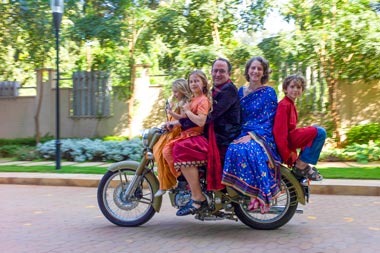
Riding the Indian way! LeeAnn Deemer and family.
LeAnn Deemer from the Bay Area came to India in 2006 for a year when her husband had a job with Yahoo. The Deemers moved back to Bangalore a year and half ago from Singapore when LeAnn’s husband started his own software development consulting and training company, GoodAgile Pvt. Ltd., “as things seemed to have only gotten better for expats here. Bangalore is most expat-friendly in terms of climate and more advanced in terms of Western amenities which are driven by the NRI market here.”
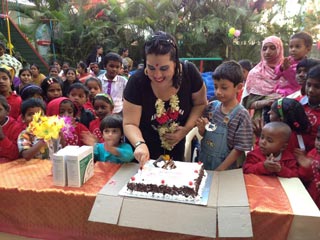
Anubis Nirvana and her children celebrating at an orphanage.
While grateful foreigners sing its praises, it’s obvious that Bangalore, too, has benefitted from the presence of these expats. Many expatriates bring with them the ethos of volunteerism and social welfare from their country. Anubis Nirvana, who is a UNESCO-certified belly dancing and Latin American dance teacher, has started a program called Dance for Charity, which enables her and her students to provide food, free dance performances, and other amenities to orphanages in Bangalore. Savage, who is interested in poverty alleviation, co-founded Unitus Capital (UC), a social investment bank that raises money for businesses that impact society, such as microfinance, health care, affordable housing, renewable energy, education, and agriculture in India and selectively across Asia.
Children and Schooling
The large number of international schools in Bangalore
offering international board certificates such as
the IGCSE affiliated to Cambridge, U.K., with unique
courses, hands-on, and experiential learning are highly
popular among expats. Deemer wanted a school
that taught Mandarin as her children were learning
it in Singapore and found one in Bangalore that does!
Anubis Nirvana’s children, being four and eight years
old now, adapted easily because they are young. “Coming
from the Middle East, where all activities are
indoors, they enjoy being outdoors and can even
walk to school. Though they have to learn Hindi, they
are happy here,” says the relieved mom.
While moving with children to a new country can be challenging, the general consensus is that the younger the child when she moves, the easier she adapts. Tally Ben recalls, “We worried how the kids would adjust.” She needn’t have worried, because her son, who was three when they moved, has no memory of Israel now, while her older child, who was six then, is happy to have both worlds—Israel and India!
Savage’s kids were so young when they moved that they are practically Indian! He narrates an anecdote from a couple of summers ago. When his children were driving home with their grandma in Toledo, Ohio, one of them said, “I have to go pee!” Grandma said, “You’ll have to wait until we get home.” Pointing to a random yard on the road, they said, “Can we just pee in the grass?”
Transition and Traffic Woes
But understandably, everything isn’t hunky-dory.
The most difficult part is the settling-in period and getting
used to a new culture. De Travos says, “It was very
hard initially because I came alone. In 1994, there were
no places like Coffee Day, only five-star hotels. There
were no supermarkets, one had to go a local market
but didn’t know what to buy, didn’t know the names of
food. It was also very hard to make friends and to deal with the loneliness and the different culture.”
Deemer remembers, “When we moved in 2007, it was our first time in Asia. It was harder than expected, getting things running for the house, and finding anything that resembled a grocery was a challenge.”
When the Savages moved here, they had two-year-old twins and a newborn, “so life would have been tough anywhere. The adjustment to Bangalore was really tough as the twins went to school for the first time, we didn’t have any help, were living in a service apartment, trying to find a car, driver, apartment, help, get bank accounts, phones, etc. Setting up the company was much easier as we were incubated by another organization that had a presence here.”
Chapman feels the most difficult things were “the amount of time it takes to get anything done and the time I had to spend in the car to commute. The traffic is hideous. Even doing things like trying to sort out furnishing the house and getting curtains, bedspreads, and pots and pans took months.”
“I had visited Mumbai a few times and also made a preliminary visit before moving. So India was not new, the sights were not new; yet, when we moved, it was very different. When we’re inside our house, it’s like a bubble; outside is a completely different world,” says Tally Ben.
Even after adapting to the unfamiliar, it’s not easy to let go of strings attached to the old life. Besides family, friends, and food, the sports, culture, and amenities are the things most expats miss from back home. Chapman misses “the good roads, water I can drink from the tap, and the excellent museums, symphonies, and other art and cultural institutions that were at my doorstep” while Deemer misses “the order, and certain everyday things that we take for granted.”
Women’s Safety
There’s been a lot of debate in recent months
about the safety of women in India, with many countries
declaring India unsafe for women tourists. While
expat women working in corporations may have additional
safety measures from their companies, expat
wives and others have to fend for themselves.
Are they concerned about their safety? When she first
came to India in 1994 and lived in Delhi, de Travos felt
extremely safe. “I traveled extensively around India
alone in buses, trains, and never felt threatened. I used
to walk in south Delhi late at night. But now, things
have changed and I don’t feel as safe today.”
Ben, though, says that she feels quite safe here. “I even walk on streets though people dissuade me, but I try not to stick out.” Nirvana, on the other hand, is worried about her security and even gave up a job at a dance school as she had to commute late alone.
Chapman, who’s also the president of the Overseas Women’s Club (OWC) that helps ease the transition into Bangalore life for newly arriving members, holds events—large and small—virtually every day of the month to promote sociability amongst members. She is not concerned much about the safety but is rather miffed at the attitude towards women here. “I find that there is often a general perception that women are less capable than men and are not taken as seriously. I have had drivers who have not lasted past 10 a.m. on the first day because they refuse to work for a woman. As the president of an organization here, GM and highranking executive of other companies abroad, I take umbrage at being treated as a second-class citizen, especially a less intelligent or capable one.”
Grace Ann, who moved from the Silicon Valley six months ago for a job in the IT sector, says being a single mom with two children is very hard in India. “Most people assume that there is a man in the family, especially when we travel. Safety-wise, I feel quite safe, though the staring can be uncomfortable. I don’t travel alone; we’re cocooned even when traveling.”
“Take –Home” Experience
Living as an expat in any country has its pros and
cons, but in the end, it’s what each one makes of their
experiences here. Deemer observes, “The U.S. is so big
and rich that it’s easy for Americans to feel that they
don’t need to know or care about the rest of the world.
Of course, it has made us very conscious of our privileges
growing up and having citizenship in a rich, developed
country, and we appreciate the good things
about the U.S. more now when we visit, and it has
made the world seem so much more interesting.”
Deepa Padmanaban writes about people, human rights, travel, education, and all things Indian.
Enjoyed reading Khabar magazine? Subscribe to Khabar and get a full digital copy of this Indian-American community magazine.
blog comments powered by Disqus










